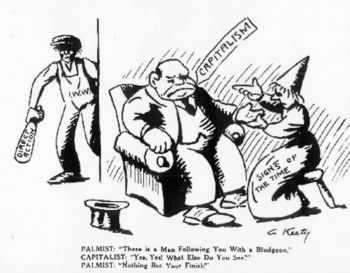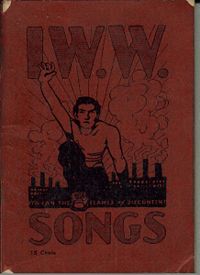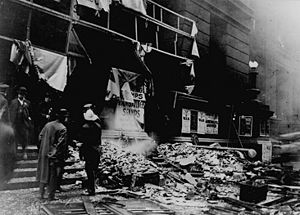Industrial Workers Of The World
 From Conservapedia
From Conservapedia 
Today, the radical un-patriotic IWW still attempts to undermine American businesses by agitating their employees around grievances. For example, in New York City and elsewhere, IWW agitators have successfully created a "union" of Starbucks employees in an effort to bring the Starbucks company to its knees. Additionally, open-border pro-Mexican IWW's have caused trouble for Jimmy John's sandwich company. Having started a Jimmy John's workers "union" in Minneapolis, IWWs insist on attacking Jimmy John's for its support of conservative values, such as Arizona's courageous new law against illegals.
Contents
- 1 History
- 2 Direct action
- 3 Legacy
- 4 Further reading
- 5 References
- 6 External links
History[edit]

The IWW was founded in 1905 by radical labor leaders "Big Bill" Haywood, an avowed atheist[2] and later Communist.[3] Other founding members include Mother Jones, Eugene V. Debs, Daniel De Leon, Thomas J. Hagerty, Lucy Parsons, William Trautmann, Vincent Saint John, and Ralph Chaplin.[4]
Direct action[edit]
- See also: Direct action
The 1909 strike against the Pressed Steel Car Company of McKees Rocks, Pennsylvania, attracted the attention of the IWW, which had a policy of "an eye for an eye, a tooth for a tooth, blood for blood."[5] According to Thomas Brewton, a staff writer for the New Media Alliance, "The IWW delivered on that threat by murdering half a dozen members of the state constabulary."[6] Among those killed in the strike violence were Pennsylvania State Troopers John L. Williams and John Curtis Smith and dozens of immigrant strikers.[7]
The IWW's largest following reached 100,000 members, making its greatest impact when it seized control of a large textile strike in Lawrence, Massachusetts in 1912. AFL union membership greatly outnumbered the active IWW contingent in Lawrence, but dramatic actions gave momentum to the IWW, much to the disgust of 'bread and butter' unionists. John Golden, president of the AFL United Textile Workers denounced the IWW action as "revolutionary" and "anarchistic" but failed to wrest the leadership of the strike away from the Wobblies. AFL President Samuel Gompers denounced the strike as a "class conscious industrial revolution ... a passing event that is not intended to be an organization for the protection of the immediate rights or promotion of the near future interests of the workers." Radical historians have celebrated the strike. When the state government sent in the militia, the IWW sent in its top firebrands, Haywood, Italian anarchist Carlo Tresca, and his wife Elizabeth Gurley Flynn later to become a top-echelon Communist. Finally, the strikers won a small pay increase and other meager demands. IWW membership swelled to 10,000 in the Lawrence textile mills, but the union proved unable to bargain on a routine basis for its members.
The IWW is well known for its many strikes, such as the 1912 Lawrence textile strike and the 1913 Paterson silk strike, of which Margaret Sanger was actively involved. At the Paterson silk strike, protesters held up banners proclaiming "No God and No Master."[8] But the IWW is most famous for the execution of IWW member Joe Hill. As Brewton recounts:
| “ | In 1914 Salt Lake City former policeman John Morrison and his son Arling were shot dead by gunmen as they were closing their small grocery store for the night. Before being shot to death, Arling managed to fire the store’s pistol at the intruders.
A younger son, who was in the rear of the store when the gunmen burst into the store, heard one of them shout, “We’ve got you now.” It was noted in the subsequent trial that Morrison had quit the police force because of threats from IWW members whose activities he had confronted while enforcing the law. An hour and a half after the murders, Dr. Frank McHugh was awakened at his home by IWW member Joe Hill, who had a gunshot wound in his chest. As he was being treated, a revolver slipped from his pocket to the floor. Hearing about the Morrison murders the next day, Dr. McHugh alerted the police. Joe Hill was arrested, convicted, and executed for the murders.[9] |
” |

In 1916, in Everett, Washington, IWW members organized a strike in the lumber-shipping port activities. The local sheriff, seeking to disband the strikers in accordance with existing law, ran into the same violent street tactics by armed IWW members that had occurred in McKees Rocks, Pennsylvania. In the armed assault by the IWW a deputy sheriff and a lumber company official were murdered and 24 non-union workers were wounded. Strongest among miners and lumberjacks in the far west, the IWW lost its next big strike, in Patterson, New Jersey, in 1916, and membership fell to 400 radicals.
During World War I, the IWW tried to sabotage the U.S. war effort. All leading Wobblies were arrested by the Wilson Administration under the Sedition Act of 1918 and went to prison. Moments after the sentencing of 95 Wobbies (including Haywood) at the Chicago Federal Building in 1918, a bomb ripped through the building, killing four.[10] Out on appeal in 1921, Haywood fled to Moscow, where he became a trusted adviser to the Bolshevik government.[11]
That year, after the Bolsheviks brutally[12] crushed[13] a wave of strikes,[14] Haywood betrayed the workers, saying, "every genuine labor union in the United States ought to affiliate with the International Council of Trade and Industrial Unions with its central bureau at Moscow."[15] (The ICTIU was the phony "union" created and controlled by the Kremlin to suppress workers' rights in the Soviet Union.)[16] The union had its lowest membership in 1960, but anti-American anarchist-communists have revived the union since the 1990s. Commies still dominate the modern IWW but anarchist punk rock youth have brought a new resurgence, making the violent IWW grow considerably in recent years.
Legacy[edit]
The IWW remains an icon of the far left, who admire its bitter, often violent opposition to capitalism and its rejection of American ideals. In contrary to traditional American values, IWWs are known for their open support of radical extremists such as Earth First, Mumia Abu Jamal, homosexuals, lesbians, and transvestites, convicted criminals, Black Panthers, Mexican re-conquistas, Leonard Peltier, Judi Bari, Palestinian extremists, radical Jewish Communists, and atheists of all stripes. Current IWW poster children include members such as anarchist "professor" Noam Chomsky, UFC "Fighter" Jeff Monson, and left wing rock "musician" Tom Morello.
Further reading[edit]
- Dubofsky, Melvyn. We Shall Be All: A History of the Industrial Workers of the World (abridged ed. 2000) excerpt and text search
References[edit]
- ↑ The ABC's of Revolutionary Unionism, Industrial Workers of the World
- ↑ J. Anthony Lukas, Big Trouble: A Murder in a Small Western Town Sets Off a Struggle for the Soul of America (New York: Simon and Schuster, 1998) ISBN 0684846179, p. 236
- ↑ Jamie H. Cockfield, Black Lebeda: The Russian Famine Diary of ARA Kazan District Supervisor J. Rives Childs, 1921-1923 (Mercer University Press, 2006), ISBN 088146015X, p. 91, fn. 50
- ↑ The IWW - Its First 100 Years. Industrial Workers of the World (2005).
- ↑ Jerre Mangione and Ben Morreale, La Storia: Five Centuries of the Italian American Experience (New York: HarperCollins, 1993) ISBN 0060924411, p. 295
- ↑ Thomas E. Brewton, IWW - Organized Crime in the Labor Market, The View From 1776
- ↑ Marylynne Pitz, "Pressed Steel Car strike in McKees Rocks Reaches Centennial Anniversary," Pittsburgh Post-Gazette, August 16, 2009
- ↑ The Brass Check: A Study of American Journalism, by Upton Sinclair
- ↑ Thomas E. Brewton, IWW - Organized Crime in the Labor Market, The View From 1776
- ↑ IWW Bomb Kills Four in Chicago," The New York Times, September 5, 1918; Charles Howard McCormick, Hopeless Cases: The Hunt for the Red Scare Terrorist Bombers (Lanham, Md.: University Press of America, 2005) ISBN 0761831320, pp. 31-31
- ↑ Douglas Linder (2003), William D. Haywood, Famous Trials (University of Missouri-Kansas City School of Law)
- ↑ Scott Zenkatsu Parker, Pravda o Kronshtadte ("The Truth about Kronstadt"), ed. Mary Huey (University of Michigan)
- ↑ "Bolsheviki Crush Moscow Uprising," The New York Times, March 11, 1921
- ↑ Michael C. Hickey, A Social Contract and No Socialism, H-Russia Discussion Network (April, 2009), H-Net (Humanities and Social Sciences Online), Michigan State University
- ↑ Max Eastman, "Bill Haywood, Communist," The Liberator, April, 1921;
- ↑ Профессиональные союзы СССР (The trade unions of the USSR), cultinfo.ru; cf. Israel Getzler, Kronstadt 1917-1921: The Fate of a Soviet Democracy (Cambridge University Press, 2002) ISBN 0521894425, p. 233
| |||||||||||||||||||||||
External links[edit]
- IWW homepage
Categories: [Labor Unions] [Progressive Era] [Socialism]
↧ Download as ZWI file | Last modified: 02/24/2023 12:31:38 | 30 views
☰ Source: https://www.conservapedia.com/Industrial_Workers_of_the_World | License: CC BY-SA 3.0
 ZWI signed:
ZWI signed:
 KSF
KSF